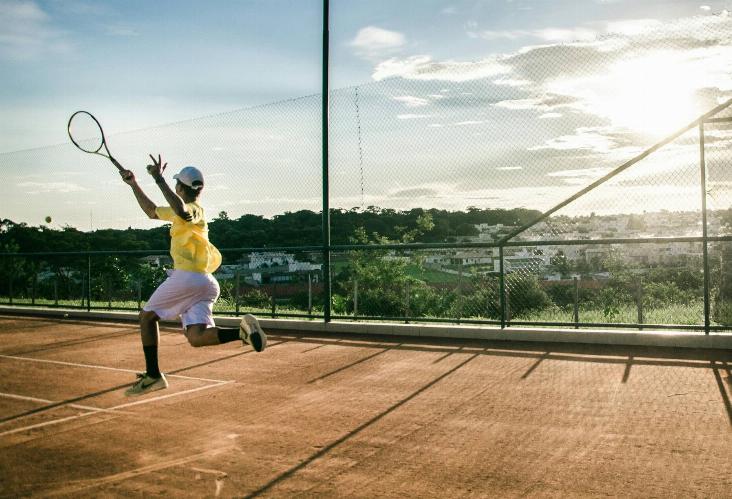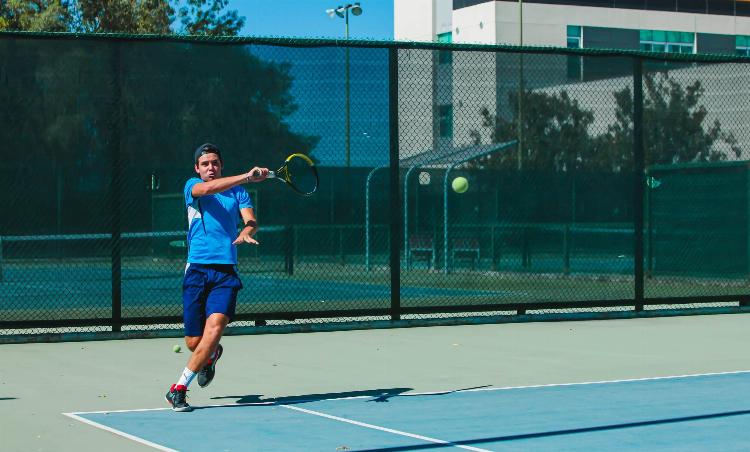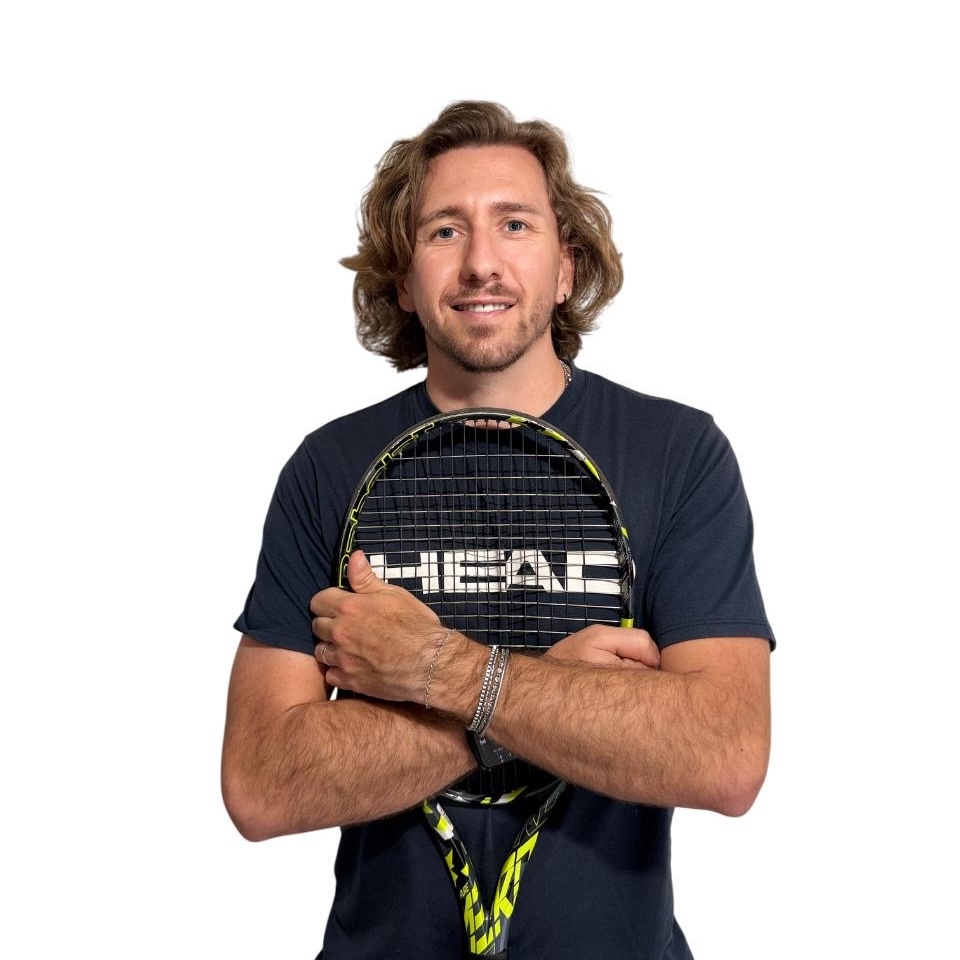Developing Speed: 6 Ways to buy time in tennis
The phone rang at 3:47 PM on a Tuesday that felt like the end of the world. Two weeks of relentless job hunting. The pay was terrible, but the opportunity was golden: working with professional players. This was my breakthrough moment.
I still remember walking onto that court for the first time—like a nervous student on the first day of school—trying to not look too bad.
The intensity was unlike anything I'd ever witnessed. Everything moved at warp speed, rallies were unfolding with surgical precision, and even the players on the back courts—the ones presumably "warming up"—were playing better tennis than I'd ever seen in my life.
Yet something wasn't adding up. These were all professional players, all operating at elite levels, but they weren't all moving at the same pace. Some glided across the court like they had extra seconds that others didn’t.
After weeks of watching, analysing, and trying to decode what I was seeing, one question haunted my thoughts: What is speed really about in tennis?
Everyone talks about taking time away from opponents, coaches scream it, commentators analyse it, players obsess over it. But the real mystery lies in the opposite direction:
How do elite players actually buy time in tennis?

Deconstructing Speed: The Science Behind Court Movement
Here's where the story gets fascinating—and where conventional wisdom crashes into cold, hard research.
Tennis speed isn't really about who can run the fastest 40-yard dash or who has the quickest feet in agility drills. The science reveals something far more elegant and complex: speed in tennis is the neuromuscular artistry of organising complex movement patterns in very short timeframes.
The data tells a compelling story. Tennis players hit approximately
• 80% of shots while moving no more than 3 meters from their ready position
• 10% of shots require 3-5 meter movement
• 10% demand runs exceeding 5 meters.
Moreover, 70% of all court movement is lateral, with only 20% involving forward motion.
Considering the short distance nature of tennis movements, the real battle isn't about reaching the ball—it's about arriving in perfect position to execute the shot you want, when you want it, with the precision that separates good players from great ones.
In this article we are gonna go through 6 ways to build speed through science based tennis training.
What neuroscience tells us is fascinating: contrary to popular belief, we don't store "muscle memory" in muscles themselves. Motor recruitment originates in the central nervous system (CNS), transmitting signals to proximal and distal muscles throughout the body.
What we talk about when we discuss tennis speed is neuromuscular efficiency—the quality of communication between brain and body, the speed of signal transmission, the precision of motor unit recruitment. Through targeted training, we can optimise the entire neuromuscular pathway, enhancing motor unit recruitment and signal transmission—the true foundation of player development.
Tennis speed, therefore, becomes primarily about neuromuscular efficiency rather than pure athleticism.
Six Pathways to Tennis Speed Mastery
1. Physical Conditioning: Building the Engine
"To be faster, run fast"—this time-tested principle remains relevant but requires strategic application in science based tennis training.
There are several ways to work on physical conditioning that transfers to on court tennis:
1. Steady-state running provides aerobic foundation essential for recovery during extended matches, though it doesn't directly enhance explosive movement. It won't make you explosive, but it builds the aerobic foundation that keeps you fresh.
2. Plyometric training leverages stretch-shortening cycles (SSC) to improve muscles' ability to generate powerful contractions after rapid stretching—crucial for tennis-specific explosive movements. But here's the critical detail: not all plyometrics transfer to tennis, so be mindful of the exercises you pick.
3. Running technique refinement is the most overlooked aspect of speed development. Proper running mechanics don't just make you faster—they make you more durable, more elegant, more economical with your energy. It also plays a big role in injury prevention.
4. Anaerobic sprint training improve lactate threshold tolerance. Sprints of varying distances does double duty: it develops explosive power while building your body's tolerance for the metabolic chaos of high-intensity rallies. When you can handle lactate buildup, you can think clearly under pressure.
5. Comprehensive strength training targeting proprioception, balance, core stability, and overall strength creates the foundation for effortless spatial movement. Without this base, you're building a Ferrari on a foundation of sand.
2. Reaction Time Optimisation: Sharpening Neural Response
Professional players average 0.24-0.5 second reaction times during match play, both inspiring and terrifying depending on your perspective.
Training reaction time is both fancy and marketable, but here's what the Instagram training videos won't tell you: isolated reaction time drills mostly won’t transfer to tennis, because tennis-specific muscle recruitment patterns are completely different from generic responses to lights or sounds.
Effective reaction time improvement occurs only through tennis-specific movement patterns—forehands, backhands, volleys, drop shot responses. The neuromuscular pathways must be trained in context to transfer meaningfully to match performance.
I learned this lesson watching a player who could catch falling objects with lightning reflexes but couldn't read a simple serve pattern. Different skill, different pathway, different training requirement.
3. Continuous Movement: The Flow State of Speed
From a biomechanical perspective, starts and stops represent the most metabolically demanding components of any movement cycle. Each complete stop forces players to restart their movement sequence, sacrificing precious momentum from previous shots.
Players starting from zero, again and again, waste precious energy and precious time.
The solution involves three key strategies:
1. Decelerate before contact rather than coming to a complete stop. This maintains momentum while allowing precise shot execution—a skill that looks effortless but requires thousands of repetitions to master.
2. Transition smoothly into acceleration instead of explosive starts from standstills. Be always in some form of motion, ready to flow into your next movement.
3. Maintain steady rhythm that fosters flow states. There's a musical quality to elite tennis movement, a cadence that allows players to stay ahead of the chaos rather than constantly reacting to it.
Here's a technical detail that changes everything: when players overswing—especially when they disproportionately use their arm and break the kinetic chain—they force themselves into inefficient, abrupt stops after contact. The harder they try to swing, the more likely they are to lose balance and waste recovery time. It's a perfect example of how technique directly impacts tennis speed.
4. Motor Chunking: Simplifying Complexity
Tennis swings involve enormous numbers of independent variables—muscles, joints, timing sequences that can overwhelm the nervous system.
Motor chunking is the elegant solution: combining individual movements into larger, manageable blocks that the nervous system can process as single units. Instead of trying to control every muscle fiber, every joint angle, every timing nuance, we create movement "chunks" that flow together seamlessly.
This approach eliminates micro-pauses, improves timing coordination, and enhances automatisation. When teaching fundamentals, combine movement into larger blocks, I personally prioritise associative movements over dissociative ones—as we all are naturally set to learn the first ones with ease.
Here's a humbling fact: only 1-2.5% of the world's population can truly multitask effectively. For the other 97.5% of us, complex movement combinations must be learned through neural pathway strengthening—repetition after repetition, session after session, until what once required conscious thought becomes automatic art.
5. Dissociation: Unlocking Advanced Movement
Motor dissociation—the ability to move different body segments independently—represents perhaps the most sophisticated aspect of tennis speed. This coordinative capacity enables swift, efficient court movement and enhanced agility.
Advanced dissociation enhances dynamic balance, movement fluidity, smooth directional changes, and quicker setup positioning. However, dissociation isn't "natural" in its refined form; it's a sophisticated motor skill that requires deliberate, focused, patient development.
The players who make this look effortless have invested thousands of hours in developing the ability to move different body segments independently. They've trained their nervous system to process multiple movement patterns simultaneously. They've earned their fluidity through systematic, scientific work.
6. Cognitive Training: The Mental Game of Speed
Court speed isn't primarily about raw sprint velocity—it's about "arriving at the right place at the right time" with maximum efficiency. This relies heavily on perceptual and cognitive capabilities.
1. Anticipation—predicting future events from partial information. This skill develops best through game-based situational training where players learn to read patterns, tendencies, and subtle cues.
2. Perceptual skills form the foundation of elite court coverage: dynamic visual acuity (seeing clearly while you or the ball are in motion), visual tracking (smoothly following trajectory), depth perception (accurately judging distance and speed), and rapid decision-making under pressure.
3. Pattern recognition allows players to identify familiar sequences in opponent behaviour, rally structure, and game situations. The best players don't just see individual shots—they see the story unfolding, the patterns emerging, the opportunities developing.
4. Working memory enables players to remember and utilise opponent tendencies,
5. Attention and focus filter the chaos of match play into actionable information.

The Holistic Speed Revolution
After those challenging initial months coaching professionals, I discovered something profound: telling players to care less about speed and more about movement quality created breakthrough improvements.
Mastering tennis speed requires a holistic player development approach blending game-based and analytical teaching methodologies. Tennis thrives on variability—no universal two-step movement pattern works for everyone. However, following these six pathways with sufficient variability in both tennis and fitness sessions develops remarkable new abilities.
The future of science based tennis training lies not in choosing between old-school intensity and modern methodology, but in intelligently combining both approaches. When players understand the neuroscience behind their movement while experiencing the joy of fluid court coverage, true speed mastery emerges.
What's your favorite drill to work on speed?
Do you wish to know more about any of the mentioned tennis speed trainings or player development?
Let's explore these training methodologies in greater depth. Reach out at hello@riccardoleone.org.
